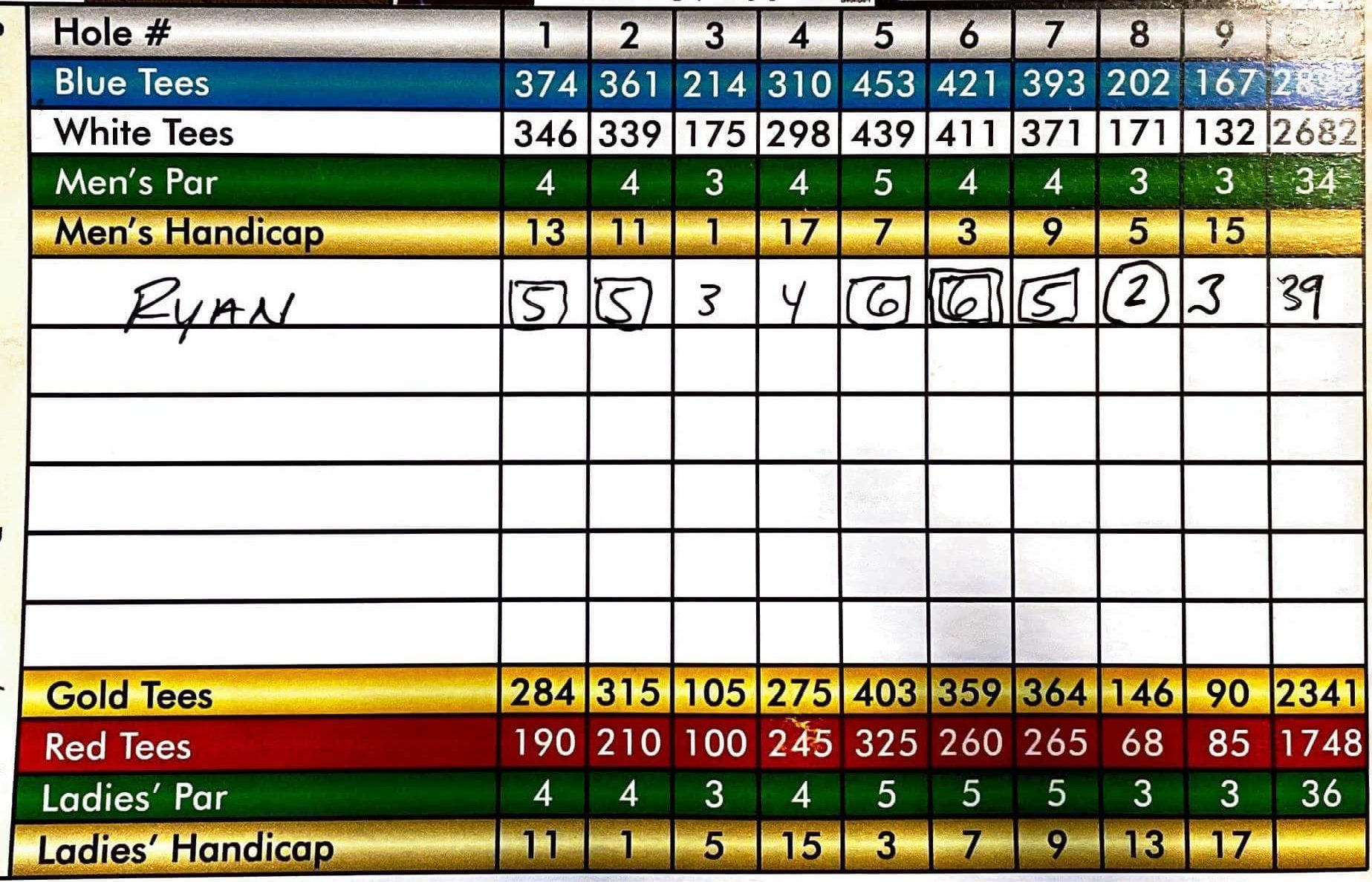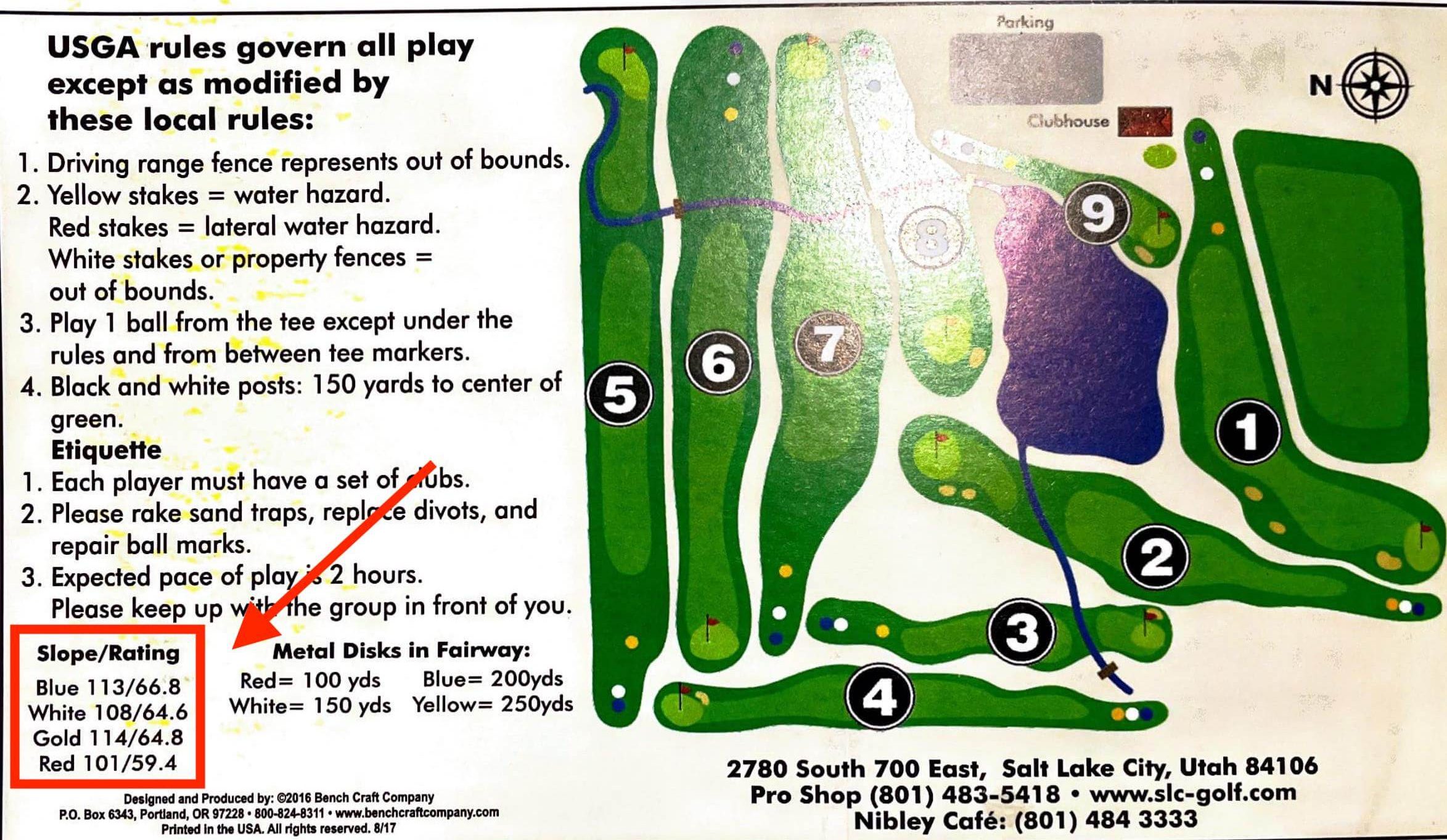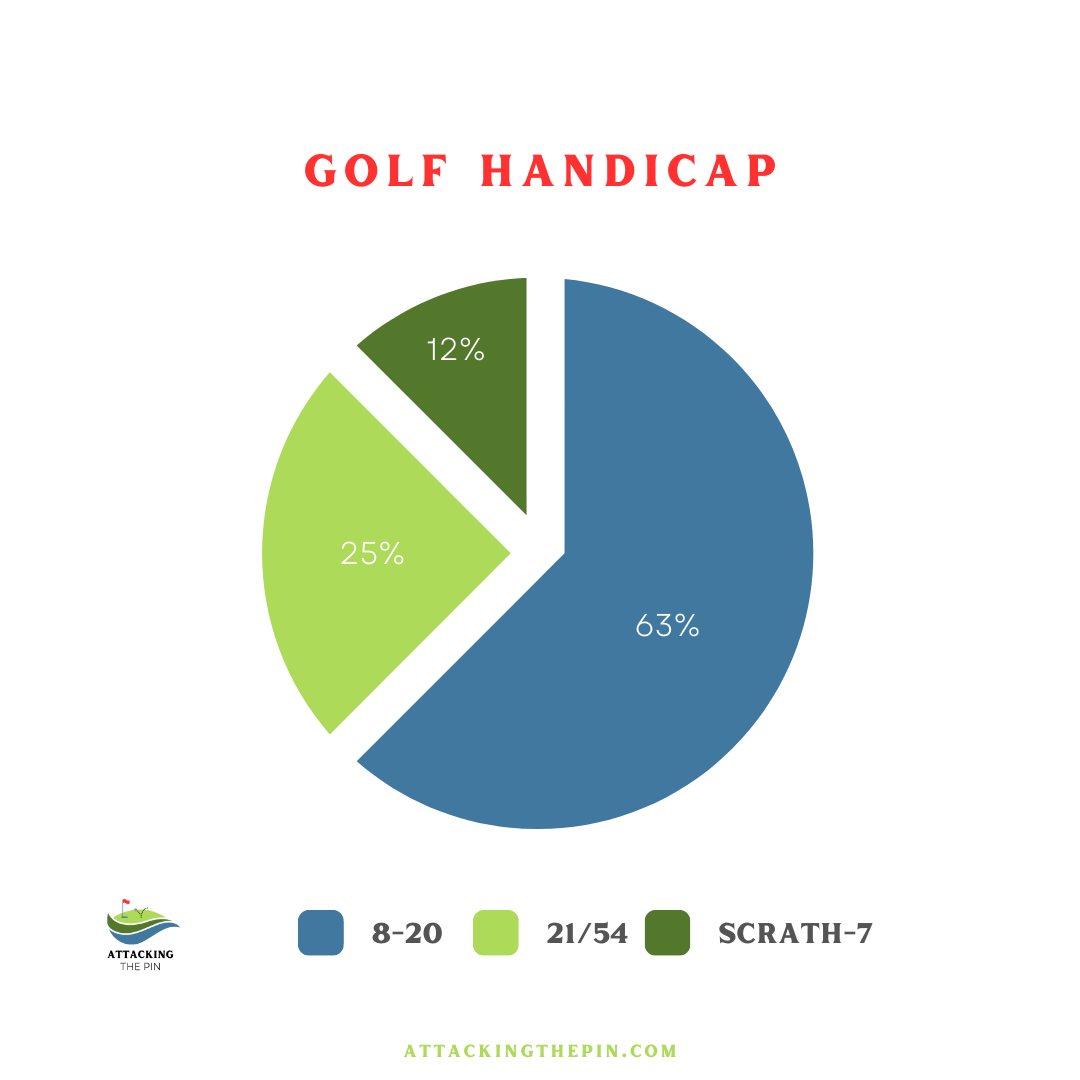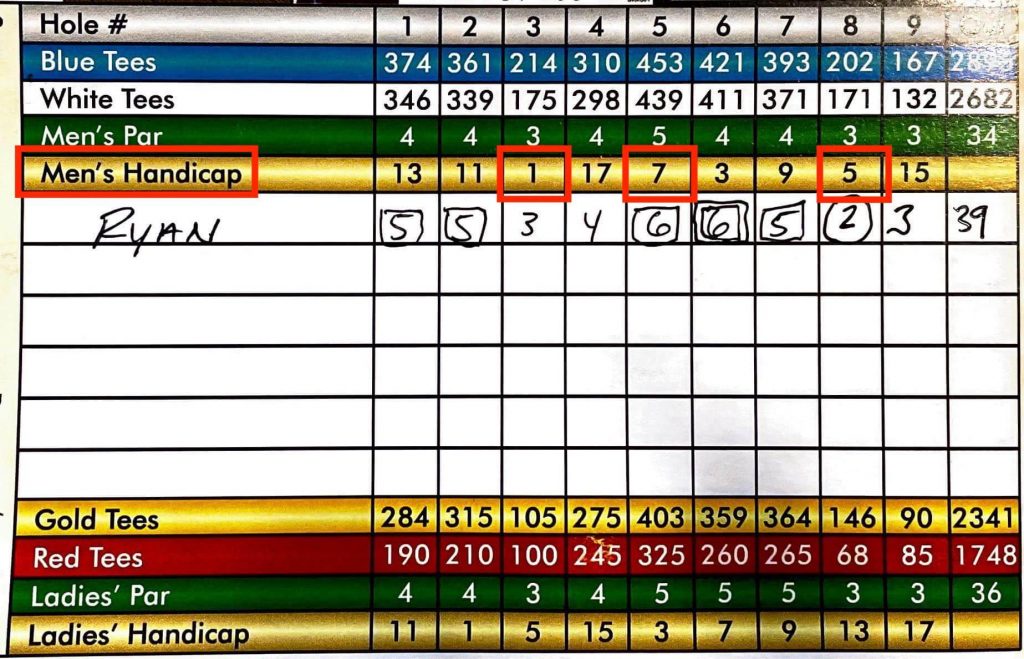If you’ve played much golf, I’m sure you’ve bumped into the concept of a golf handicap. But what does it mean?
A golf handicap is the running average of a player’s lowest 10 handicap differentials of the last 20 rounds played. The handicap differential (or the handicap based on one round of golf) is calculated using the following formula:
(Adjusted Gross Score – Course Rating) x 113 / Course Slope Rating
I’ve been a casual golfer my whole life and never taken the sport too seriously. This year, some friends convinced me to join our local men’s league, which forced me (at least that’s what I told my wife) to play golf every week.
In our league, we get our handicap calculated after every round. After playing 9 holes today and being frustrated that my handicap went up, I decided to research how to calculate golf handicap.
After dusting off my old calculator and spending many hours researching, I have compiled the ultimate guide to understanding a golf handicap.
Best Ways to Calculate Golf Handicap
Why Golf Handicap Exists
Let’s start with why a golf handicap even exists. Golf handicaps exist to help level the playing field among golfers of different skill levels. Handicaps help maintain competition when playing with people that are worse or better (for most of us) than you. As it is, golf is one of the most frustrating sports, so for me, a handicap is my saving grace when I play with better golfers.
A golf handicap is the difference between your current golf game and “the ideal” golf (aka scratch golf). As you can imagine, having a higher handicap means you’re further from scratch golf, while a better, more polished player would have a lower handicap. A handicap comes in the form of a number which represents the number of strokes above even par you would be expected to shoot. For example, a golfer with a handicap of 10 could reasonably be expected to have the potential to shoot 10-over par through 18 holes in a typical round.
The goal of a golf handicap is to measure your potential rather than your average. In order to achieve such an estimate, the golf “higher-ups” have developed a complex calculation that factors in everything imaginable and takes an already challenging sport to the next level.
What Golf Handicap Measures
As I researched, I was shocked at what golf handicap measures! Your handicap measures how hard a course is, which tees you play from, your skill level, and even those 1 or 2 really bad holes you have every round. It gets so detailed as to estimate how a course plays for a beginner versus how that course plays for an experienced golfer, including things like hitting over water or around doglegs.
There are 2 different kinds of handicaps. A handicap index and a handicap differential. A handicap index is a running handicap average based on 20 rounds of golf. A handicap differential is your handicap measured based on just 1 round of golf.
If the purpose of a golf handicap is to compare players of different skill levels, it certainly does a great job of that. If someone plays 18 holes at a professional course from the tips or back tees and shoots +10 and another person plays 9 holes from the junior tees at a municipal course it will factor in everything about the rounds so that their net scores (your score minus your handicap) will be competitive if both players play typical rounds.
Golf Handicap Key Terms
When calculating a golf handicap it is important to understand what factors go into your handicap. Remember, this takes a lot of different things into account so there are a lot of strange words and numbers involved – I’ll keep it as basic as possible:
- Course Rating – how challenging a course is for a scratch golfer (higher rating = harder course)
- Course Slope Rating – how challenging a course is for a bogey golfer (higher handicap golfer)
- Course Handicap – what your handicap is in relation to a specific course
- Your Score – The number of strokes you make during the round
- Equitable Stroke Control (ESC) – The maximum number of strokes you can have on a given hole (if the ESC is 7 and you shoot a 10 on a hole, your factored score would be 7)
- Adjusted Gross Score – Your Score based on ESC
- Handicap Differential – Your handicap based on 1 round of golf
- Handicap Index – Your running handicap
Golf Handicap Calculation
The current golf handicap calculation is a very long process. I played 9 holes today and I’ll use my scorecard as an example. Here is a step-by-step to calculate your handicap:

- Find your Handicap Differential (handicap based on one round)
(Adjusted Gross Score- Course Rating)* 113
Course Slope Rating
- Find Adjusted Gross Score
Adjusted Gross Score=Your Score-Equitable Stroke Control
- Determine your course handicap (skip this step if you’ve never calculated your handicap before)
Handicap Index * Course Slope Rating
113
- My current handicap index is 7.5 – I know this because I have an app that calculates it for me. (I do NOT do this after every time I play golf)
- I found the course slope rating is 113 on the scorecard. If the slope rating isn’t on there you can probably find it on the course website.
7.5 * 113113 = 7.5
(Yes, I remember from my 7th-grade algebra class that multiplying and dividing by the same number cancels out)

- 113 is the standard slope rating for any course so that is why it is used in the calculation (this will weight the handicap if the course is harder or easier)
- Determine your Equitable Stroke Control (ESC)
- Your ESC is the maximum number of strokes you can score on any given hole. Based on your course handicap follow the chart below to see what your ESC is:
| Course Handicap | Maximum Number of Strokes (ESC) |
| 9 or less | Double bogey |
| 10-19 | 7 |
| 20-29 | 8 |
| 30-39 | 9 |
| 40 or more | 10 |
- Interestingly, if your handicap is above 9 the ESC shown applies regardless of what the par of a particular hole is. Since my handicap is below 9, my ESC is a double-bogey which obviously takes into account the par of the hole.
- In this case, my worst hole was a double bogey so the ESC doesn’t have any effect on my score.
- Referencing above, my adjusted gross score is 39 which we will multiply by 2 (since I only played 9 holes) which comes to 78
- Calculate your handicap differential
(78 (adjusted gross score) – 66.8 (Course Rating)) * 113113 = 11.2
- Calculate your handicap index (running handicap). Remember that your index will display more of what you’re capable of rather than your average because it uses your best rounds, not your average rounds..
- The calculation for your handicap index depends on the number of rounds you have a handicap differential for.
- If you have played less than 10 rounds (handicap differentials), you will always use your lowest handicap differential as your handicap index
- Once you have 10-14 rounds under your belt, you will take the average of your 3 lowest handicap differentials (add them together and divide by 3)
- Once you have 15-19 rounds under your belt, you will repeat the process with 6.
- Once you have played 20 rounds you will take the average of your 10 lowest handicap differential calculations. Always use your 20 most recent rounds for future calculations.
Best Ways to Calculate Golf Handicap
The best ways to calculate your handicap in my opinion are anyway that doesn’t involve going through the above process. Your handicap index is a running calculation so it will change and get more accurate as you play more golf.
If you want to keep track and enjoy some of the hands-on efforts that it takes, I recommend using a spreadsheet to track your handicap. This is for those that love seeing the data and going through the process and putting in the work to analyze it. If you’re one of those people, I’m sure you can build a better spreadsheet but here is a simple Google Sheet template you can use.
If you want to track your handicap differential for just one round there are some great online calculators from the USGA and calculator.net
The best way for tracking your handicap is through an app or website. I find it easier to use my phone to track my score rather than a pencil and scorecard. There are a bunch of free tools out there, The one I use is called 18 birdies which includes both scoring features as well as great GPS yardage features. I have no affiliation with them, their app just happens to be my personal favorite (free and easy to use).
Highest Handicap in Golf
The highest handicap in golf is 54.0. I wanted to include this to help everyone feel a little better about their game. If you’ve gone through the effort of calculating your handicap I’m confident that you have a lower handicap than 54. For a lot of us, it’s a long way to scratch golf, but luckily we can all say our path is shorter than those with a 54 handicap.
Here is a breakdown of the average golf handicap:

Golf Net Score
Your golf net score is the purpose of calculating your handicap. This is how you compare your score against other players of different skill levels. This level playing field makes it possible for average Joe’s like me to compete with anyone (except the dreaded sandbaggers).
To calculate your net score for a round you just take your total score minus your handicap (always round up). With a handicap of 8, you would have an 8-stroke advantage over a scratch golfer if you were playing straight up.
If you want to calculate your net score on each hole you need to use the handicap row of the scorecard. Each hole is ranked 1-18 from hardest to easiest. Based on your handicap, you get 1 less stroke per hole per handicap. For example, if my 9-hole handicap is 3.5 that means (4 rounding up) I get 1 less stroke for the 4 hardest holes. In this case, it would be holes # 3, 6, 8, and 5.

What to do Next?
After all of that, hopefully, you have a good sense of how to calculate golf handicaps including the handicap differential and net score. Like I mentioned, the golf handicap system really does factor in everything in a golf round. When calculated correctly, your handicap index is a pretty darn accurate measurement of your skill level.
The next step is to lower your handicap! Assuming you’re not a scratch golfer already, this is what every player wants.
One of the easiest things I’ve done to post lower scores and help my handicap in the past is simply fixing the way I hold a golf club. It’s a small and easy way to eliminate a few shanks from your round. Take a look at our guide on how to hold a golf club.






